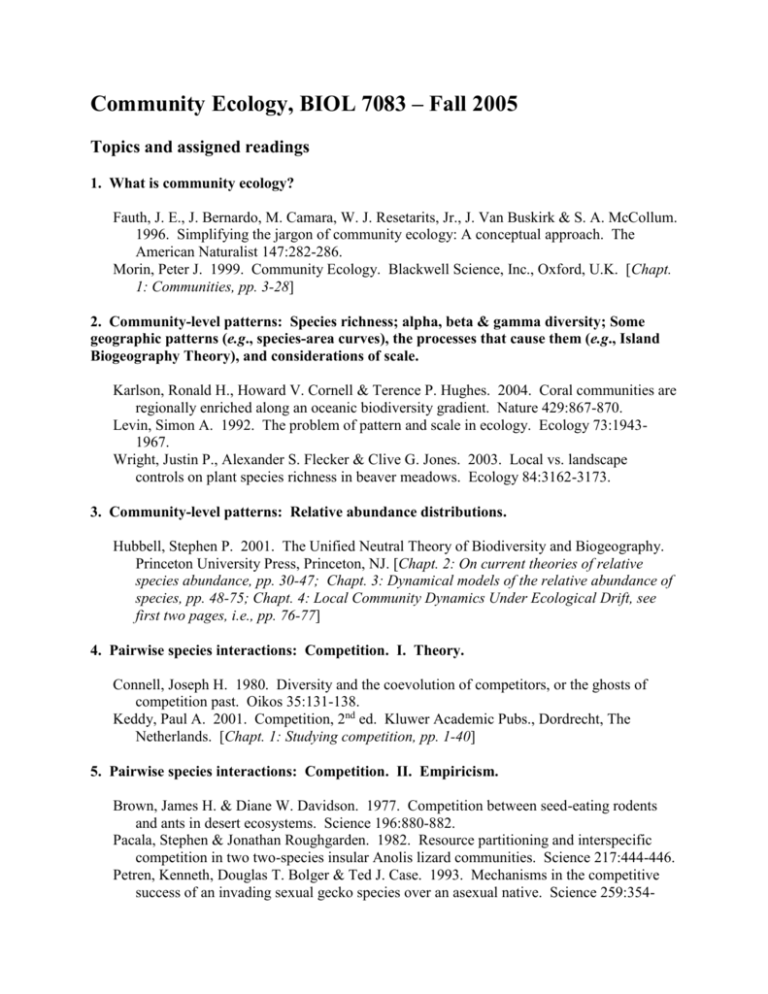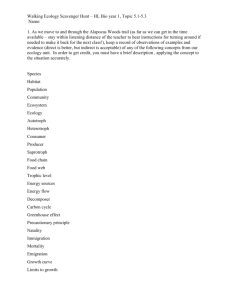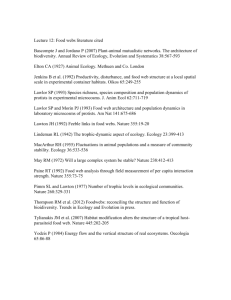doc
advertisement

Community Ecology, BIOL 7083 – Fall 2005 Topics and assigned readings 1. What is community ecology? Fauth, J. E., J. Bernardo, M. Camara, W. J. Resetarits, Jr., J. Van Buskirk & S. A. McCollum. 1996. Simplifying the jargon of community ecology: A conceptual approach. The American Naturalist 147:282-286. Morin, Peter J. 1999. Community Ecology. Blackwell Science, Inc., Oxford, U.K. [Chapt. 1: Communities, pp. 3-28] 2. Community-level patterns: Species richness; alpha, beta & gamma diversity; Some geographic patterns (e.g., species-area curves), the processes that cause them (e.g., Island Biogeography Theory), and considerations of scale. Karlson, Ronald H., Howard V. Cornell & Terence P. Hughes. 2004. Coral communities are regionally enriched along an oceanic biodiversity gradient. Nature 429:867-870. Levin, Simon A. 1992. The problem of pattern and scale in ecology. Ecology 73:19431967. Wright, Justin P., Alexander S. Flecker & Clive G. Jones. 2003. Local vs. landscape controls on plant species richness in beaver meadows. Ecology 84:3162-3173. 3. Community-level patterns: Relative abundance distributions. Hubbell, Stephen P. 2001. The Unified Neutral Theory of Biodiversity and Biogeography. Princeton University Press, Princeton, NJ. [Chapt. 2: On current theories of relative species abundance, pp. 30-47; Chapt. 3: Dynamical models of the relative abundance of species, pp. 48-75; Chapt. 4: Local Community Dynamics Under Ecological Drift, see first two pages, i.e., pp. 76-77] 4. Pairwise species interactions: Competition. I. Theory. Connell, Joseph H. 1980. Diversity and the coevolution of competitors, or the ghosts of competition past. Oikos 35:131-138. Keddy, Paul A. 2001. Competition, 2nd ed. Kluwer Academic Pubs., Dordrecht, The Netherlands. [Chapt. 1: Studying competition, pp. 1-40] 5. Pairwise species interactions: Competition. II. Empiricism. Brown, James H. & Diane W. Davidson. 1977. Competition between seed-eating rodents and ants in desert ecosystems. Science 196:880-882. Pacala, Stephen & Jonathan Roughgarden. 1982. Resource partitioning and interspecific competition in two two-species insular Anolis lizard communities. Science 217:444-446. Petren, Kenneth, Douglas T. Bolger & Ted J. Case. 1993. Mechanisms in the competitive success of an invading sexual gecko species over an asexual native. Science 259:354- 358. 6. Pairwise species interactions: Predator-prey, parasitoid-host & parasite-host interactions. Loyn, Richard H., Ross G. Runnalls & Gail Y. Forward. 1983. Territorial Bell Miners and other birds affecting populations of insect prey. Science 221:1411-1413. Parker, Ingrid M. & Gregory S. Gilbert. 2004. The evolutionary ecology of novel plantpathogen interactions. Annual Review of Ecology, Evolution & Systematics 35:675-700. 7. Pairwise species interactions: Herbivory. Coley, P. D. & J. A. Barone. 1996. Herbivory and plant defenses in tropical forests. Annual Review of Ecology and Systematics. 27:305-335. Marquis, Robert J. 1984. Leaf herbivores decrease fitness of a tropical plant. Science 226:537-539. 8. Pairwise species interactions: Mutualisms (pollination, seed dispersal, trophic & defense symbioses, etc.). Bertness, Mark D. & Ragan Callaway. 1994. Positive interactions in communities. Trends in Ecology and Evolution 9:191-193. Kiers, E. Toby, Robert A. Rousseau, Stuart A. West & R. Ford Denison. 2003. Host sanctions and the legume-rhizobium mutualism. Nature 425:78-81. Wheelwright, Nathaniel T. & Gordon H. Orians. 1982. Seed dispersal by animals: Contrasts with pollen dispersal, problems of terminology, and constraints on coevolution. The American Naturalist 119:402-413. 9. Multiple species interactions: Food webs, higher-order interactions, indirect effects (e.g., apparent competition, ecosystem engineers, keystone predators, trophic cascades, etc.). Dyer, Lee A. & Deborah Letourneau. 2003. Top-down and bottom-up diversity cascades in detrital vs. living food webs. Ecology Letters 6:60-68. Jones, Clive G., Richard S. Ostfeld, Michele P. Richard, Eric M. Schauber & Jerry O. Wolff. 1998. Chain reactions linking acorns to gypsy moth outbreaks and lyme disease risk. Science 279:1023-1026. Strong, Donald R. 1992. Are trophic cascades all wet? Differentiation and donor-control in speciose ecosystems. Ecology 73:747-754. 10. Origins and maintenance of species diversity and diversity gradients. I. Theory and selected empirical examples. Hubbell, Stephen P. & Robin B. Foster. 1986. Biology, chance and history and the structure of tropical rain forest tree communities. Pp. 314-329 in J. Diamond & T. J. Case, eds., Community Ecology. Harper and Row, NY, NY. Tilman, David & Stephen Pacala. 1993. Pp. 13-25 in Robert E. Ricklefs & Dolph Schulter, eds., Species Diversity in Ecological Communities: Historical and Geographical Perspectives. The University of Chicago Press, Chicago, IL. 11. Origins and maintenance of species diversity and diversity gradients. II. Phylogenetic perspectives, assembly rules (including priority effects, and contrasts with ecological filters or sieves), community-level convergence, extended phenotypes, and etc. Cadle, John E. & Harry W. Green. 1993. Phylogenetic patterns, biogeography, and the ecological structure of Neotropical snake assemblages. Pp. 281-293 in Robert E. Ricklefs & Dolph Schulter, eds., Species Diversity in Ecological Communities: Historical and Geographical Perspectives. The University of Chicago Press, Chicago, IL. Losos, Jonathan B. 1996. Phylogenetic perspectives on community ecology. Ecology 77:1344-1354. Ricklefs, Robert E. 1987. Community diversity: Relative roles of local and regional processes. Science 235:167-171. 12. Diversity-productivity, diversity-stability, and diversity-invasibility relationships. Levine, Jonathan M. 2000. Species diversity and biological invasions: Relating local process to community pattern. Science 288:852-854. Mittelbach, Gary G., Christopher F. Steiner, Samuel M. Scheiner, Katherine L. Gross, Heather L. Reynolds, Robert B. Waide, Michael R. Willig, Stanley I. Dodson & Laura Gough. 2001. What is the observed relationship between species richness and productivity? Ecology 82:2381-2396. 13. Disturbance and ecological succession. Connell, J. H. & R. O. Slatyer. 1977. Mechanisms of succession in natural communities and their role in community stability and organization. The American Naturalist 111:11191144. Sousa, W. P. 1984. The role of disturbance in natural communities. Annual Review of Ecology and Systematics 15:353-391. 14. Scaling relationships within communities. Enquist, Brian J., John P. Haskell & Bruce H. Tiffney. 2002. General patterns of taxonomic and biomass partitioning in extant and fossil plant communities. Nature 419:610-613. Enquist, Brian J. & Karl J. Niklas. 2001. Invariant scaling relations across tree-dominated communities. Nature 410:655-660. Sugihara, G. & R.M. May. 1990. Applications of fractals in ecology. Trends in Ecology and Evolution 5:79-86. 15. Community and ecosystem ecology plus conservation within human-dominated landscapes; Global change. Ehrlich, Paul R. & Edward O. Wilson. 1991. Biodiversity studies: Science and policy. Science 253:758-762. [Reasons to preserve biodiversity: ethics, esthetics, economics & ecosystem services.] Sanders, Nathan J., Nichoas J. Gotelli, Nicole E. Heller & Deborah M. Gordon. 2003. Community disassembly by an invasive species. Proceedings of the National Academy of Science, USA 100:2474-2477. Vitousek, Peter M., Harold A. Mooney, Jane Lubchenco & Jerry M. Melillo. 1997. Human domination of Earth's ecosystems. Science 277: 494-499.








